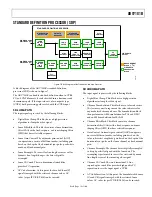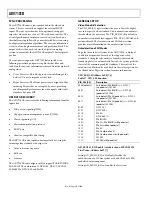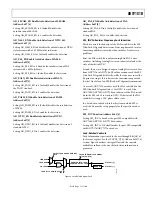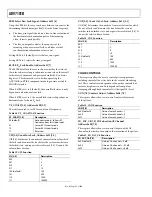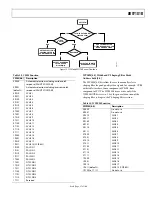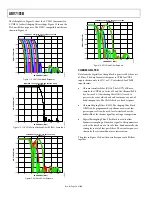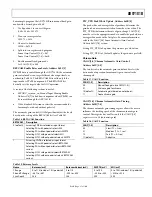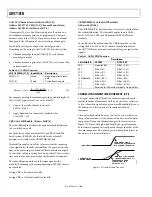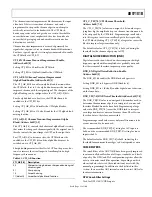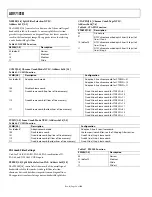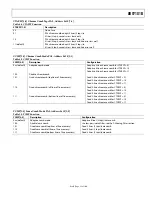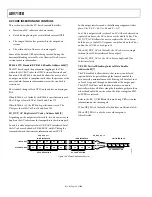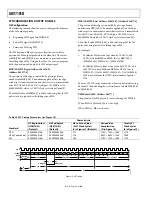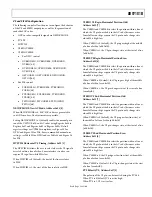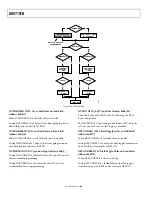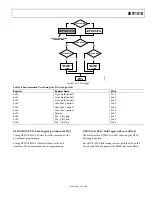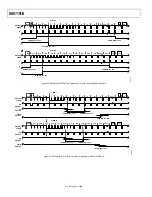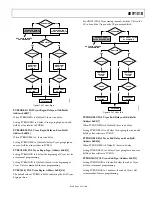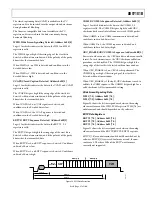
ADV7181B
Rev. B | Page 33 of 100
The chroma transient improvement block examines the input
video data. It detects transitions of chroma, and can be
programmed to steepen the chroma edges in an attempt to
artificially restore lost color bandwidth. The CTI block,
however, operates only on edges above a certain threshold to
ensure that noise is not emphasized. Care has been taken to
ensure that edge ringing and undesirable saturation or hue
distortion are avoided.
Chroma transient improvements are needed primarily for
signals that experienced severe chroma bandwidth limitations.
For those types of signals, it is strongly recommended to enable
the CTI block via CTI_EN.
CTI_EN Chroma Transient Improvement Enable,
Address 0x4D[0]
Setting CTI_EN to 0 disables the CTI block.
Setting CTI_EN to 1 (default) enables the CTI block.
CTI_AB_EN Chroma Transient Improvement
Alpha Blend Enable, Address 0x4D[1]
The CTI_AB_EN bit enables an alpha-blend function within
the CTI block. If set to 1, the alpha blender mixes the transient
improved chroma with the original signal. The sharpness of the
alpha blending can be configured via the CTI_AB[1:0] bits.
For the alpha blender to be active, the CTI block must be
enabled via the CTI_EN bit.
Setting CTI_AB_EN to 0 disables the CTI alpha blender.
Setting CTI_AB_EN to 1 (default) enables the CTI alpha-blend
mixing function.
CTI_AB[1:0] Chroma Transient Improvement Alpha
Blend, Address 0x4D[3:2]
The CTI_AB[1:0] controls the behavior of alpha blend circuitry
that mixes the sharpened chroma signal with the original one. It
thereby controls the visual impact of CTI on the output data.
For CTI_AB[1:0] to become active, the CTI block must be
enabled via the CTI_EN bit, and the alpha blender must be
switched on via CTI_AB_EN.
Sharp blending maximizes the effect of CTI on the picture, but
can also increase the visual impact of small amplitude, high
frequency chroma noise.
Table 42. CTI_AB Function
CTI_AB[1:0] Description
00
Sharpest mixing between sharpened and original
chroma signal
01 Sharp
mixing
10 Smooth
mixing
11 (default)
Smoothest alpha blend function
CTI_C_TH[7:0] CTI Chroma Threshold,
Address 0x4E[7:0]
The CTI_C_TH[7:0] value is an unsigned, 8-bit number speci-
fying how big the amplitude step in a chroma transition must be
to be steepened by the CTI block. Programming a small value
into this register causes even smaller edges to be steepened by
the CTI block. Making CTI_C_TH[7:0] a large value causes the
block to improve large transitions only.
The default value for CTI_C_TH[7:0] is 0x08, indicating the
threshold for the chroma edges prior to CTI.
DIGITAL NOISE REDUCTION (DNR)
Digital noise reduction is based on the assumption that high
frequency signals with low amplitude are probably noise and
that their removal, therefore, improves picture quality.
DNR_EN Digital Noise Reduction Enable,
Address 0x4D[5]
The DNR_EN bit enables the DNR block or bypasses it.
Setting DNR_EN to 0 bypasses DNR (disables it).
Setting DNR_EN to 1 (default) enables digital noise reduction
on the luma data.
DNR_TH[7:0] DNR Noise Threshold, Address 0x50[7:0]
The DNR_TH[7:0] value is an unsigned 8-bit number used to
determine the maximum edge that is interpreted as noise and
therefore blanked from the luma data. Programming a large
value into DNR_TH[7:0] causes the DNR block to interpret
even large transients as noise and remove them. The effect on
the video data is, therefore, more visible.
Programming a small value causes only small transients to be
seen as noise and to be removed.
The recommended DNR_TH[7:0] setting for A/V inputs is
0x04, and the recommended DNR_TH[7:0] setting for tuner
inputs is 0x0A.
The default value for DNR_TH[7:0] is 0x08, indicating the
threshold for maximum luma edges to be interpreted as noise.
COMB FILTERS
The comb filters of the ADV7181B have been greatly improved
to automatically handle video of all types, standards, and levels
of quality. The NTSC and PAL configuration registers allow the
user to customize comb filter operation, depending on which
video standard is detected (by autodetection) or selected (by
manual programming). In addition to the bits listed in this
section, there are other ADI internal controls; contact ADI sales
for more information.
NTSC Comb Filter Settings
Used for NTSC-M/J CVBS inputs.

